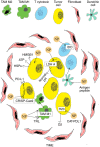Nanomedicine to modulate immunotherapy in cutaneous melanoma (Review)
- PMID: 33815608
- PMCID: PMC8014970
- DOI: 10.3892/etm.2021.9967
Nanomedicine to modulate immunotherapy in cutaneous melanoma (Review)
Abstract
Cancer immunotherapy has shifted the paradigm in cancer treatment in recent years. Immune checkpoint blockage (ICB), the active cancer vaccination and chimeric antigen receptor (CAR) for T-cell-based adoptive cell transfer represent the main developments, achieving a surprising increased survival in patients included in clinical trials. In spite of these results, the current state-of-the-art immunotherapy has its limitations in efficacy. The existence of an interdisciplinary interface involving current knowledge in biology, immunology, bioengineering and materials science represents important progress in increasing the effectiveness of immunotherapy in cancer. Cutaneous melanoma remains a difficult cancer to treat, in which immunotherapy is a major therapeutic option. In fact, enhancing immunotherapy is possible using sophisticated biomedical nanotechnology platforms of organic or inorganic materials or engineering various immune cells to enhance the immune system. In addition, biological devices have developed, changing the approach to and treatment results in melanoma. In this review, we present different modalities to modulate the immune system, as well as opportunities and challenges in melanoma treatment.
Keywords: cutaneous melanoma; immunotherapy; nano-agents; nanomedicine; nanotechnology.
Copyright: © Volovat et al.
Conflict of interest statement
The authors declare that they have no competing interests.
Figures

References
Publication types
LinkOut - more resources
Full Text Sources
Other Literature Sources
